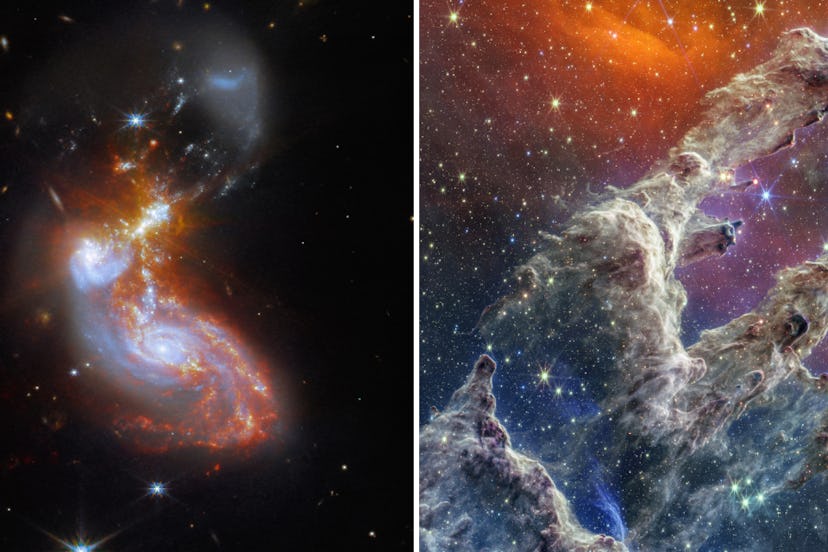New JWST Photos Reveal A Handful Of Galaxies In Astounding Clarity
NASA released new photos taken by the incredible telescope showing two brand new galaxies, plus another look at an old, magical sight.

The James Webb Space Telescope (JWST) continues to capture incredible space landscapes. NASA recently released new photos taken by the telescope showing two brand new galaxies, plus another look at an old, magical sight that we just can’t get enough of: the Pillars of Creation.
The new images came from an international mission led by NASA, partnering with the Canadian Space Agency (CSA) and the European Space Agency (ESA).
Explaining the new galaxy photos like you’re 5:
According to NASA, the new images from the JWST show a pair of galaxies called II ZW 96, which is roughly 500 million light-years away from Earth. It’s close to the celestial equator, which can be thought of as Earth’s equator projected onto the celestial sphere, or an imaginary sphere projected into space with the observer smack dab at the sphere’s center, according to Almanac.com.
For some context, the Sun is approximately 8.3 light-minutes away from us, which means that when seeing the Sun, we see what the Sun looked like about 8.3 minutes ago. So, the images the JWST captured of II ZW 96 are what that galaxy looked like nearly 500 million years ago.
The II ZW 96 Galaxies, Explained
In the photo, we can see the merging of two galaxies, which is why NASA describes the image as “a chaotic, disturbed shape.” We can also see the galaxies’ two bright centers, which are connected by “bright tendrils of star-forming regions,” NASA explains. The spiral-like arms at the bottom “have been twisted out of shape by the gravitational perturbation of the galaxy merger.”
Basically, these two galaxies collide and merge thanks to their gravitational pull, leading to a stunning image.
JWST was able to capture the merging galaxy pair using its Mid-Infrared Instrument (MIRI), and the Near-Infrared Camera (NIRCam) since the galaxy pair is “particularly bright at infrared wavelengths thanks to the presence of the star formation.”
The New Pillars Of Creation Photo, Explained
NASA also released another new image of the Pillars of Creation — gorgeous group of stars and dusty pillars in the Eagle Nebula. The Pillars of Creation stretches from about four to five light-years away from Earth, according to NASA.
These fire-like clouds have been captured by the JWST several times before, and each image has been absolutely spectacular. The dust and gas that surrounds the Pillars of Creation are picked up perfectly with the telescope’s NIRCam.
For more information, be sure to check out NASA’s details on these new photos.
This article was originally published on